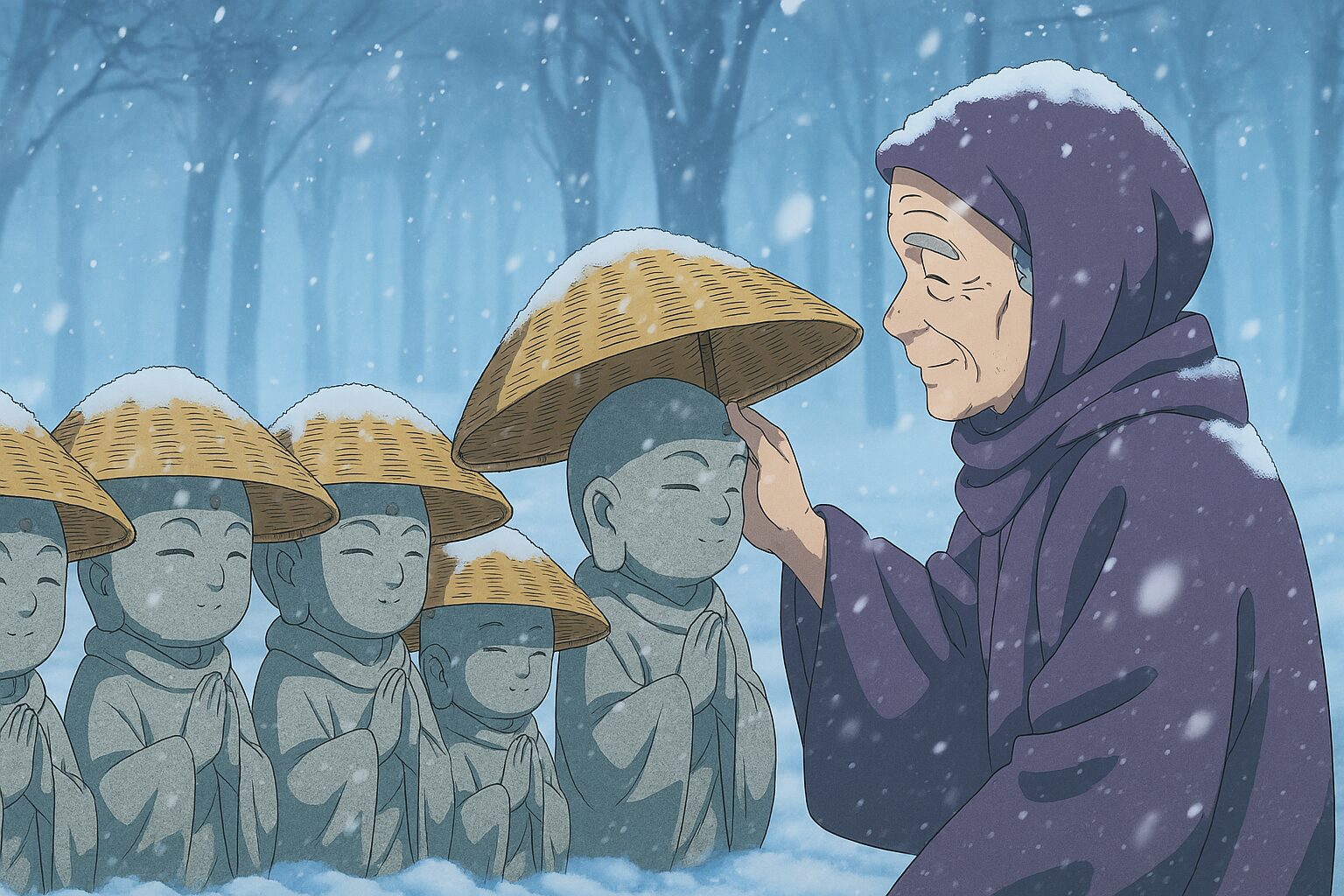- Introduction: Timeless Lessons from Japanese Folktales
- Setting and Characters
- The Full Story: A Winter Miracle
- What Is a Jizo? A Cultural Explanation
- The Values Behind the Story
- Why This Tale Resonates Globally
- Comparison with Other Japanese Folktales
- Conclusion: A Story That Warms the Heart
- References and Further Reading
- はじめに:昔話に込められた「見返りを求めない優しさ」
- 登場人物と舞台設定
- 物語の詳細:雪の日に起こった奇跡
- 地蔵とは何か?文化的背景の解説
- 物語に込められた価値観
- 海外読者へのメッセージ
- 他の昔話との比較
- まとめ:『笠地蔵』が語る冬の奇跡
- 関連リンク・参考資料
Introduction: Timeless Lessons from Japanese Folktales
Japanese folktales are more than children’s stories—they are vessels of cultural wisdom. They reflect values like compassion, gratitude, and harmony with nature. One such tale is Kasa Jizo, a winter story that quietly celebrates selfless kindness and the miracles it can bring.
Setting and Characters
- The Old Man: A gentle, hardworking soul who weaves straw hats to sell in town.
- The Old Woman: His supportive wife, hopeful for New Year’s preparations.
- Six Jizo Statues: Stone Buddhist guardians standing silently at the village outskirts, watching over passersby.
The Full Story: A Winter Miracle
Chapter 1: Preparing for the New Year
On a snowy day just before New Year’s Eve, the old woman asks her husband to sell handmade straw hats in town. With the money, they hope to buy rice cakes and decorations for the holiday. The old man sets off through the snow-covered paths.
Chapter 2: A Disappointing Day
In town, the old man tries to sell his hats, calling out to passersby. But everyone is too busy, and no one stops. As evening falls, he returns home with all the unsold hats, discouraged and cold.
Chapter 3: The Jizo in the Snow
On his way back, he notices six Jizo statues standing quietly in the snow, their heads and shoulders covered in frost. Moved by their silent presence, he gently places his straw hats on each statue to shield them from the cold. For the sixth statue, he removes his own headscarf and wraps it around its head.
Chapter 4: A Strange Sound in the Night
Back home, he tells his wife what happened. She smiles warmly, proud of his kindness. That night, as snow continues to fall, they hear a mysterious sound outside—“thump, thump, thump”—but they stay in bed, puzzled.
Chapter 5: A Gift of Gratitude
At dawn, they open the door and are stunned. In front of their house are piles of rice, vegetables, dried fish, and festive goods. Footprints in the snow lead away from the house—six sets, just like the Jizo statues. The couple bows deeply, realizing the Jizo had come to thank them.
What Is a Jizo? A Cultural Explanation
Jizo Bodhisattva is a beloved figure in Japanese Buddhism, known for protecting children, travelers, and souls in the afterlife. Jizo statues are found along roadsides, temples, and cemeteries, often dressed with hats or bibs by locals.
Learn more on Wikipedia: Jizo Bodhisattva.
The Values Behind the Story
- Selfless Compassion: Helping others without expecting anything in return.
- Karma and Gratitude: Good deeds are rewarded in unexpected ways.
- Harmony with Nature: The snow, silence, and season deepen the emotional impact.
Why This Tale Resonates Globally
Though rooted in Japanese tradition, the message of Kasa Jizo is universal. It reminds us that kindness transcends language and culture, and that even small gestures can lead to profound outcomes.
Comparison with Other Japanese Folktales
Unlike action-packed tales like Momotaro or Issun Boshi, Kasa Jizo is quiet and introspective. It focuses not on heroism, but on the beauty of a gentle heart.
Explore more stories in the Japanese Folktale Series.
Conclusion: A Story That Warms the Heart
Kasa Jizo is a tale of winter, humility, and human warmth. For readers around the world, it offers a glimpse into Japanese values and a reminder that kindness is always worth sharing.
References and Further Reading
❄️雪の中に宿る思いやり:『笠地蔵』が語る日本の心
はじめに:昔話に込められた「見返りを求めない優しさ」
日本の昔話は、自然との共生、人と人との関係性、そして「思いやり」や「感謝」といった普遍的な価値が込められています。『笠地蔵』は、冬の寒さの中で起こる小さな奇跡を描いた物語です。
登場人物と舞台設定
- おじいさん:心優しく、働き者。手作りの笠を編んで町へ売りに行く。
- おばあさん:慎ましく、夫を支える存在。正月の準備を心待ちにしている。
- 六体のお地蔵さま:村の外れに並んで立っている石仏。雪の中、静かに人々を見守っている。
物語の詳細:雪の日に起こった奇跡
第一章:年の瀬の準備
大晦日を目前に控えた寒い冬の日。おばあさんは、正月に食べる餅や米を買うために、夫に笠を編んでもらいます。おじいさんは町へ向かいますが、雪が降り積もり、道は白く覆われていきます。
第二章:笠が売れなかった日
町に着いたおじいさんは笠を売ろうとしますが、誰も足を止めてくれません。夕方になっても一枚も売れず、肩を落として帰路につきます。
第三章:地蔵さまとの出会い
村の外れで六体のお地蔵さまを見かけたおじいさんは、売れ残った笠を一つずつかぶせていきます。最後の一体には自分の頭巾をかぶせて帰宅します。
第四章:静かな夜と不思議な音
その夜、外は吹雪。深夜、「どっさり、どっさり」という音が聞こえ、二人は不思議に思いながらも眠りにつきます。
第五章:恩返しの朝
翌朝、戸を開けると、家の前には米俵、餅、野菜、干物などが山のように積まれていました。雪の上には地蔵さまの足跡が並んでいます。二人は静かに手を合わせ、感謝の気持ちを込めて祈ります。
地蔵とは何か?文化的背景の解説
地蔵菩薩は、日本の仏教において苦しむ人々を救う存在です。特に子ども、旅人、病人、亡くなった人の魂を守るとされ、全国各地に祀られています。
詳しくは、Wikipedia「地蔵菩薩」をご参照ください。
物語に込められた価値観
- 無償の思いやり:見返りを求めず、困っている存在に手を差し伸べる心。
- 因果応報:善行は巡り巡って自分に返ってくるという仏教的教え。
- 自然との共生:雪や季節の描写を通じて、自然と人の関係性を描く。
海外読者へのメッセージ
この物語は、文化や宗教の違いを超えて、誰もが共感できる普遍的なテーマを語っています。思いやりは言葉を超え、小さな善意が大きな奇跡を生むことを教えてくれます。
他の昔話との比較
『笠地蔵』は、戦いや冒険を描く『桃太郎』や『一寸法師』とは異なり、静かで内面的な物語です。アクションよりも「心の美しさ」が中心に据えられています。
他の昔話については、日本昔話シリーズ(ブログ内)をご覧ください。
まとめ:『笠地蔵』が語る冬の奇跡
『笠地蔵』は、寒い冬の中に灯る「人の温もり」を描いた物語です。日本の文化や価値観を知らない海外の読者にとっても、心に響く内容となるでしょう。



コメント